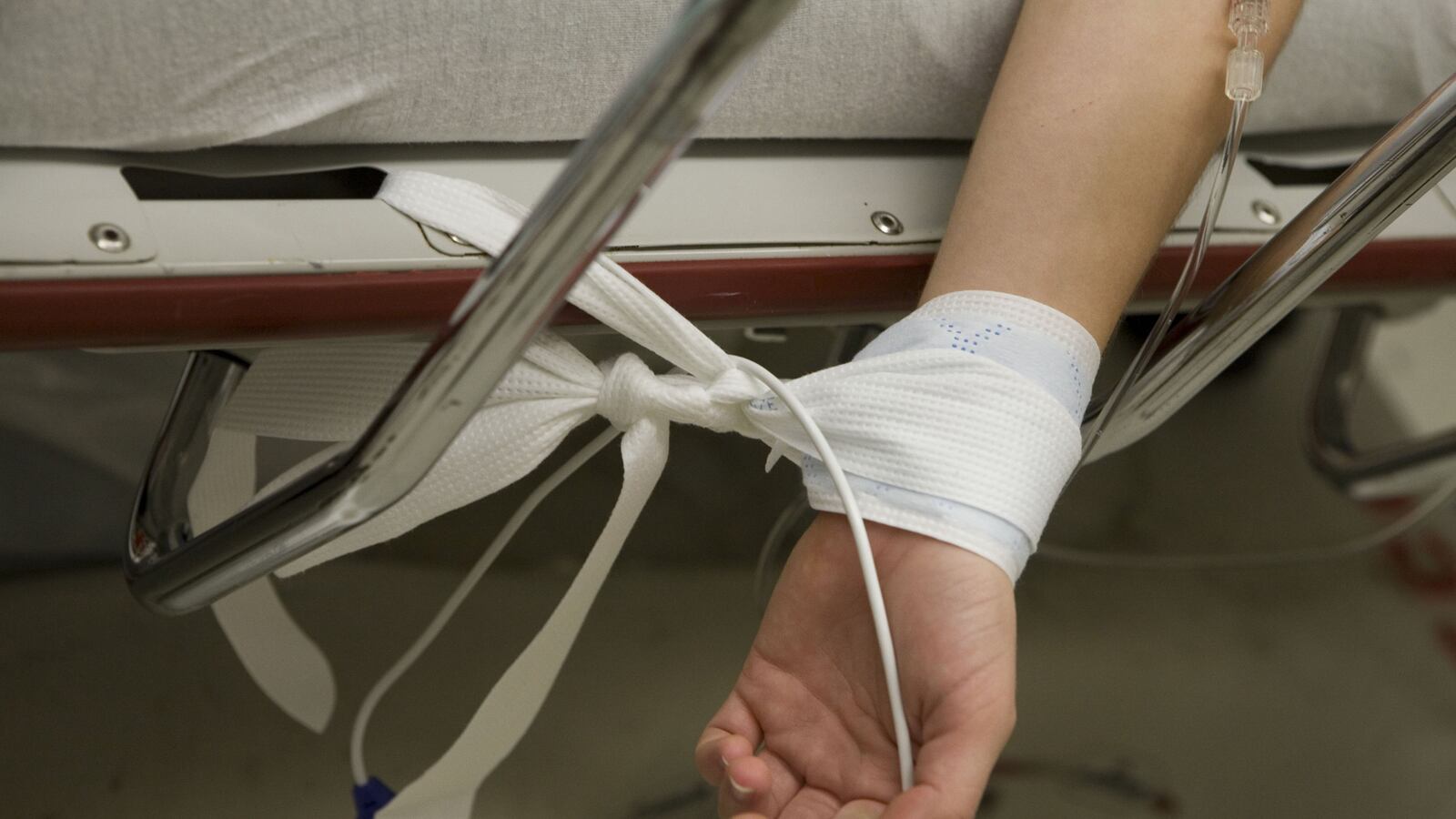Excruciating emergency-room wait times and prison-like boarding conditions for adults dealing with mental-health crises are well known. Yet we rarely hear about the kids who have to endure such squalid treatment.

When you think of hospitalized children, you think of emergencies like broken arms and asthma attacks. But young, mentally-ill inpatients are tragically common. In fact, one in ten hospitalized kids are admitted due to a mental health condition, according to a new study to be published in the journal Pediatrics next month. Depression is the most common and costly reason kids are turning up in the ER, accounting for 44 percent of all mental-health admissions of young people ages three to 20, and $1.33 billion annually in hospital charges.
Other common reasons for hospitalization are bipolar disorder and psychoses, two relatively rare conditions in the general population. Yet both often require frequen hospital care. “The fact that they’re hospitalized as frequently as they are means that these kids are really quite sick and we need to be paying attention to how to provide the best care for them,” says Dr. Naomi Bardach, lead author and assistant professor of pediatrics at UCSF Benioff Children’s Hospital.
If, for the first time, we have a clear picture of why kids with mental health disorders—and there are over 4 million of them, or one in five children under 18 according to the CDC—are seeking medical help, the question follows: Just how effective is hospitalization? And what about the ones who never make it past the ER’s waiting room?
Mental-health hospitalizations for kids are on the rise—up 24 percent from 2007 to 2010. For mood disorders like depression and bipolar disorder, the hospitalization rate has jumped 80 percent since 1997. While the need for urgent care continues to grow, the number of facilities throughout the country equipped to treat these children are steadily declining, at considerable costs to families. And even when urgent care is adequate, the reality of mental health is such that by the time most children end up in emergency rooms, the system has already failed them.
Late last year, Marie Yates’ 17-year-old son, Steven (diagnosed with schizophrenia, autism and bipolar disorder) was denied a bed in a Phoenix mental health facility after he used scissors to cut his throat in a suicide attempt at school. He stayed for 11 days in the hospital before being discharged. So when Steven became suicidal again in January, Yates took him to another ER, this time one linked with a mental health care center. Again, she was told there was no space for her child. Steven was eventually admitted by the hospital, but only after Yates physically brought her son to the Behavioral Health Center a block away. “You might have to call the cops,” she said as a staff member opened the door, “because I’m not leaving.”
Emily Bell, CEO for the trade association representing Arizona’s behavioral health workers, described the number of inpatient beds for children in the state as “woefully short.”
Boise’s Intermountain Hospital is just one of the most recent hospitals to reduce its capacity for psychiatric patients—cutting 17 beds last year. Now, when the 30 adolescent spaces get full, children are sent to neighboring emergency rooms like the one at St. Luke’s Hospital, which has neither the space nor the resources to treat non-life-threatening psychiatric issues. St. Luke’s Medical Director for Outpatient Pediatrics echoed the frustration of other emergency departments to a local reporter on a segment about the hospital bed reductions: “What do we do with them when they have particularly complex mental health needs?”
CBS also documented the problem on 60 Minutes in January. It highlighted the emergency room at Yale-New Haven Hospital in Connecticut, where 52 psychiatric beds were full, leaving seven young people waiting for care—five of them for at least three days.
Sadly, these anecdotes are neither new nor unique.
In the 2006 landmark case Rosie D. v. Romney, a Massachusetts judge ruled in favor of thousands of children with serious emotional disabilities, some of whom spent days lying in hallway hospital beds waiting for treatment. The court found that by inappropriately detaining or denying access to children in need of mental-health treatment and failing to provide home-based services, the state had violated the Federal Medicaid Act.
Massachusetts has made real progress (PDF) in complying with the ruling—the number of children screened and provided with services for behavioral health conditions has increased significantly, as has the number of professionals tasked with providing these services. Nationally, though, the problem persists.
The issue of access to mental-health care took on a tragic urgency after 20-year-old Adam Lanza, a boy with a long history of mental illness, killed 26 people at Sandy Hook Elementary school in 2012. It resurfaced again last year when it was discovered that Virginia State Senator Creigh Deeds’ son, Gus, had been turned away from a mental-health care facility in Virginia hours before attacking his father and killing himself.
Though both the 23-year-old Gus Deeds and Adam Lanza were technically young adults at the time of their attacks, their problems had started years earlier. And since half of all mental health disorders start by 14 years of age (PDF), earlier intervention and quality care has a direct impact on an individual’s life, and on the overall mental health of the country.
Following high-profile tragedies like Sandy Hook, politicians have been quick to offer platitutdes about reforming the country’s broken mental-health system—but such rhetoric rarely results in lasting change.
“There hasn’t been enough action or investment,” says Darcy Gruttadaro, Director of the National Alliance on Mental Illness (NAMI) Child & Adolescent Action Center.
“As soon as a financial crisis or economic downturn happens, often mental health is back on the chopping block,” Gruttadaro says. “And that’s a penny wise and a pound foolish because we end up paying ultimately when we don’t provide adequate service and supports.”
Indeed, overall state mental-health budgets are continually being cut. A report from NAMI found that states cut over $1.6 billion from their mental health agency budgets from fiscal year 2009 to 2012.
When you add in cuts to other services that affect mental-health programs like Medicaid, the National Association of State Mental Health Program Directors (NASMPHD) (PDF) estimates the cuts end up at $4.35 billion.
As suicide is the third leading cause of death in young people ages 15-25, few would disagree that hospital beds are needed to help stabilize kids in crisis—though child health experts agree that a hospital shouldn’t be the first or only option.
But for many parents, it is. A series of focus groups led by Maryland’s Department of Health found that even though families consistently reported hospitals to be unhelpful, the emergency department was the service accessed most often by families with children “in crisis,” e.g. displaying violent behavior or threatening self-harm. Along with judgmental treatment, the parents consistently complained of long delays and inability to access treatment: “We were there three days waiting for a bed,” one parent said.
When asked “what would help,” families spoke about the desire to skip the ER in favor of direct urgent mental-health services, facilities that have been proven to reduce the need for inpatient psychiatric beds by up to 75 percent.
Further, these families stressed the need for more individualized treatment and services like “wraparound care,” a community-based approach that involves a team of people dedicated to the well-being of the child.
Indeed, experts note that more targeted prevention, outreach, and treatment services would in fact reduce the need for expensive and ineffective hospital care. As Portland, Oregon emergency physician Sharon Meieran said in a recent column for the Oregonian on the barbaric treatment of teen psych patients, “The question of whether someone must board in the [Emergency Departments] is challenging, but by the time we are even considering the question, it’s too late.”






